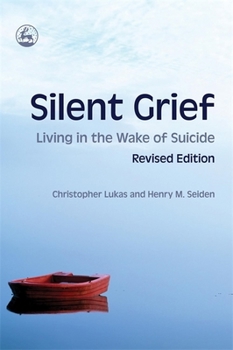Silent Grief: Living in the Wake of Suicide Revised Edition
Select Format
Select Condition 
Book Overview
This book gives insights into the pain and suffering involved when people are grieving for someone who has committed suicide, but it also offers hope without diminishing the significance of the suffering involved. As such, it has a lot to offer, and is therefore to be welcomed.'
Format:Paperback
Language:English
ISBN:184310847X
ISBN13:9781843108474
Release Date:March 2007
Publisher:Jessica Kingsley Publishers
Length:224 Pages
Weight:0.72 lbs.
Dimensions:0.5" x 6.0" x 9.0"
Customer Reviews
4 ratings
Compassionate and comforting
Published by Thriftbooks.com User , 16 years ago
Those left behind in the wake of a suicide do not need nor cannot take in a mass of psychological jargon, statistical abstracts or pie charts and graphs. What they need is the reassurance that they are not alone, that there is a community of compassionate, sensitive people which will welcome them as they try to absorb and accept their loss. "Silent Grief" provides a real service in helping the reader to sort out his feelings and to begin to make sense of the senseless. Authors Lukas and Seiden provide many real life examples of the behaviors of suicide survivors. These should be helpful to anyone who has lost a loved one to suicide, no matter how long ago the event occurred, no matter how close emotionally the survivor was to the deceased, even if they were not family. Although they do not mention Elisabeth Kubler-Ross by name, Lukas and Seiden do detail her famous five stages of grief, (from her 1969 book, "On Death and Dying") and explain that these emotions and behaviors can and often do run deeper in suicide survivors than in those mourning the death, say, of an elderly person who dies of natural causes. The stages of grief and the order in which they are experienced are denial, anger, bargaining, depression and finally, acceptance. Not everyone goes through all the stages, regardless of the intensity or nature of their loss. But there are suicide survivors who get stuck in one stage of grief never to leave it, not for years or even decades. "Silent Grief" discusses not only why this happens, but the ways in which the suicide survivor can become "unstuck," and finally achieve acceptance of his loss. To work one's way through the process of grieving can take years. I lost a brother to suicide in 1995. He was only 31. The authors discuss deep, unrelenting depression as a primary cause of almost every suicide. This my brother experienced for years, and it seemed resistant to treatment. Now, although there are days when I feel his presence acutely, and other days when it seems as if his death just occurred, I did eventually reach the acceptance phase, but it took about six years. (I don't know if this was a long or short period of time, nor even if there are any meaningful yardsticks.) I don't believe it is the intention of Lukas and Seiden to encourage the reader in accelerating the grieving process. Rather, their many real-life examples make it easier to understand the complexities, the patience and the backtracking that will inevitably mark the road to recovery. It has been said that while a suicide survivor will never get over it, he can eventually get used to it. Only by completing this process can acceptance of this unimaginably painful event be achieved. "Silent Grief" offers hope that one day acceptance can be achieved, and that the process may be arduous, but reaching this vital last stage of the journey does not mean abandoning the memory of or forgetting the one who died. Those who need to read "Silent Grief" know who they are,
Don't think about it, just get it.
Published by Thriftbooks.com User , 18 years ago
Do it for yourself. I didn't know what to do when my teenage son died. People don't understand suicide and it carried so many stigmas I was afraid to talk about it. With no family support and my husband unwilling/unable to discuss this issue I found this book was my companion and consolation. It helped me understand emotions that had me so confused. It gave credence to my own emotions which I tried to hide. No one ever "gets over it", but I did learn to cope with the help of sage advice from books like this. Another healer for me was, "After Suicide", but "Silent Grief" was the best. After such a tragedy trying to focus on reading was really difficult so be patient. I found this book is so easy to follow. It related to me when no one else could. I hope it helps others just as much as it did me. I realized what is was to "bargain".
I'm Not Alone
Published by Thriftbooks.com User , 24 years ago
In 1989, my baby brother committed suicide. It has been said that, "Death is Final!" Death by Suicide never ends for the survivors. I have a wonderful friend, who gave me Silent Grief. It was a constant friend, which walked me through some very heartbreaking times. It is like a friend who holds your hand and lets you know that it is always there, and you are not alone. The way the book is presented is a great help. People are different and need different support. Once you read it, you can pick it up and zero in on the areas that can be of more help to you as an individual. With the help of this book, I've realized that even though the haunting of Clyde's death will be forever with me, life does go on and the pain eases. Thank you to the author for such a great contribution to our world.
Silent Grief
Published by Thriftbooks.com User , 24 years ago
This is a thorough work on suicide and it's aftermath. It is clear,concise,comforting. Full of help for the family and friends;highly recommended.





